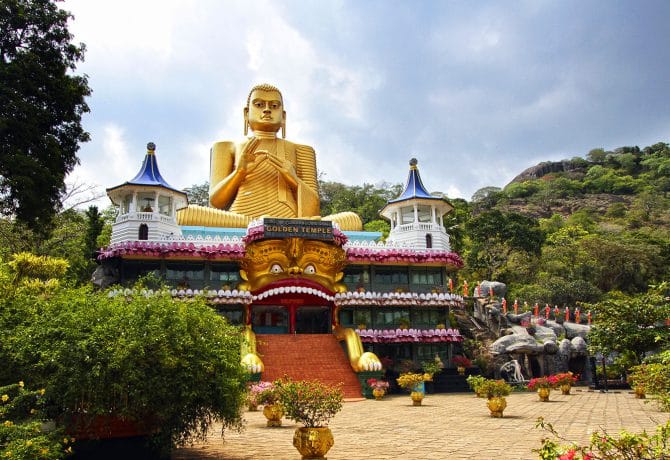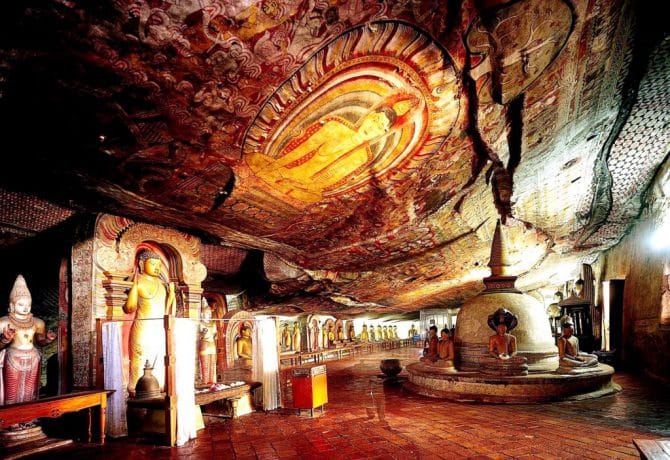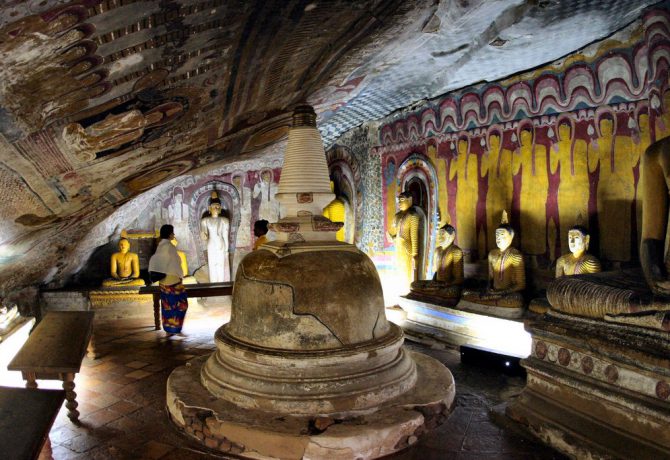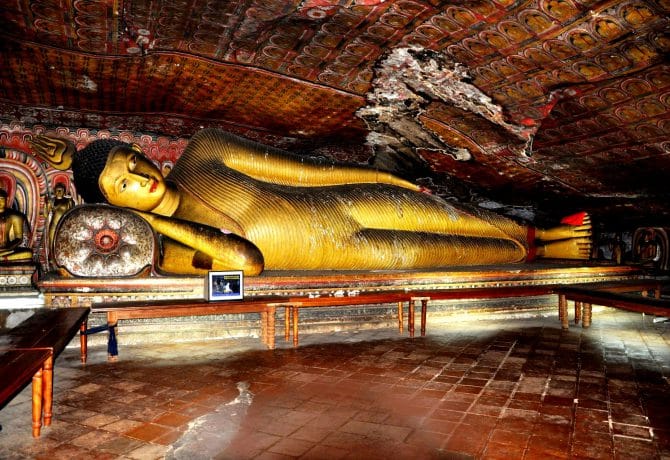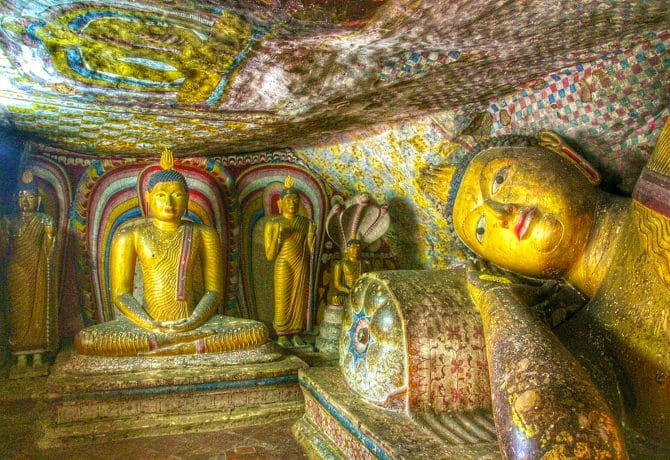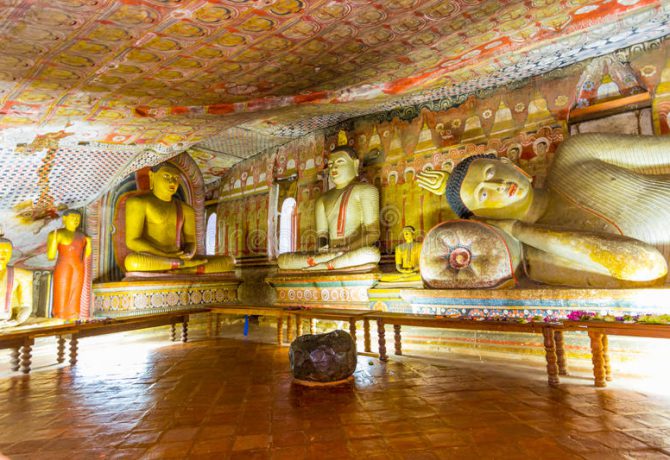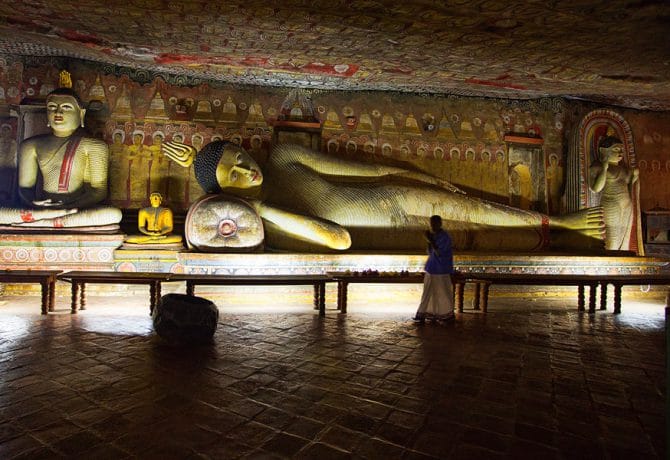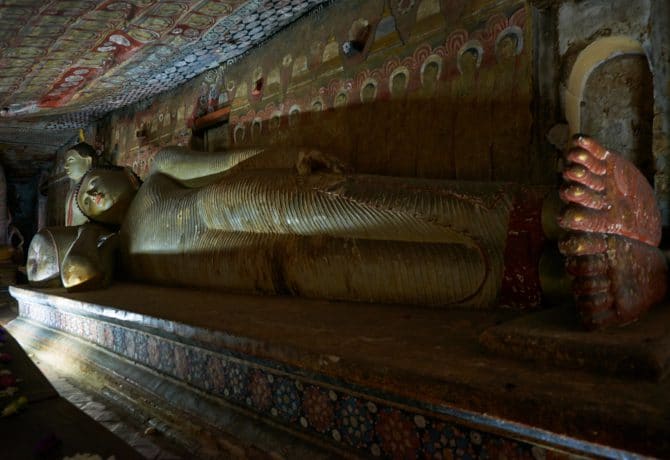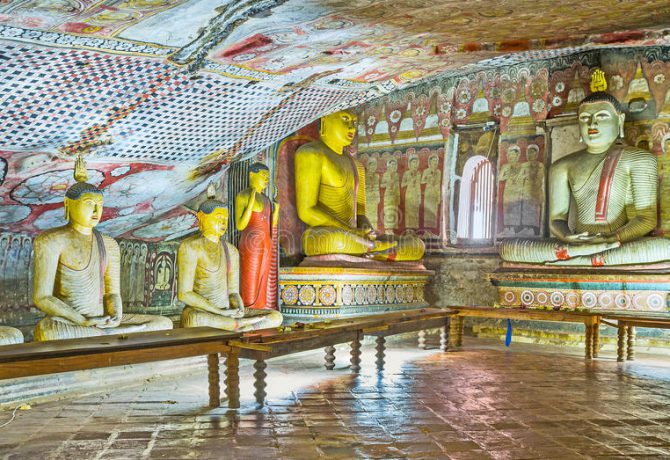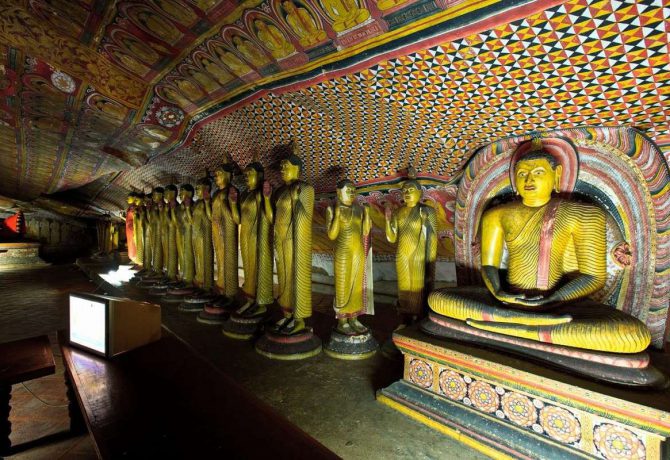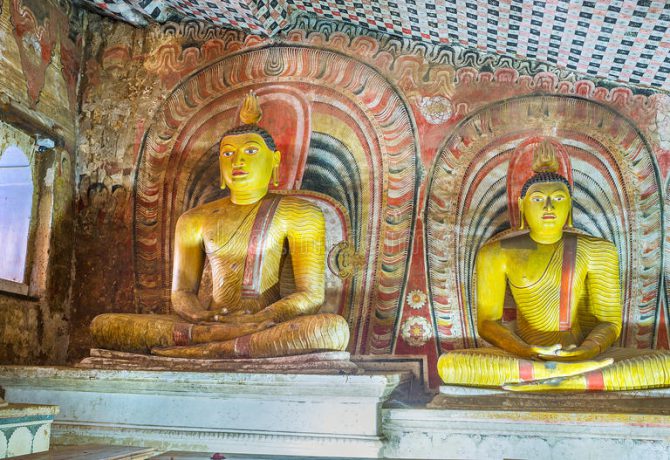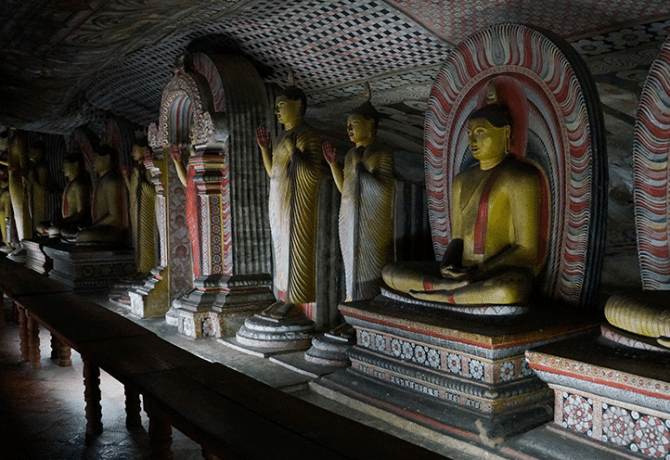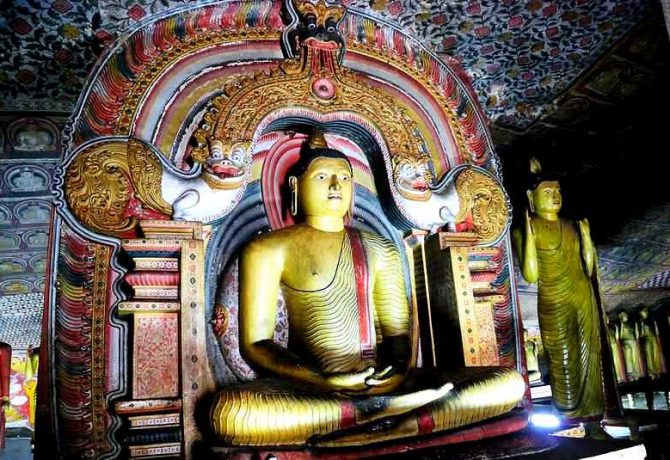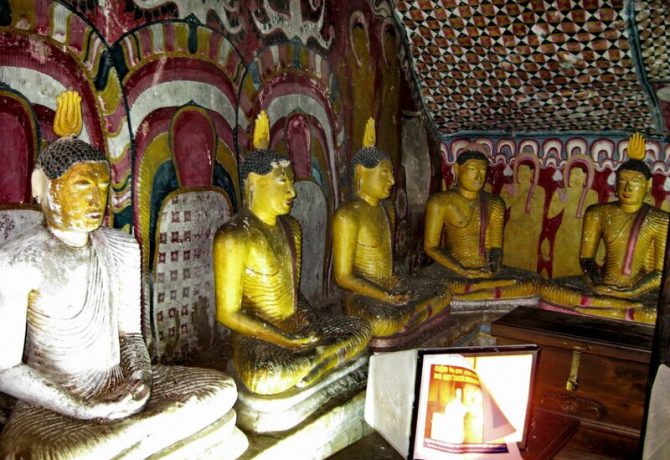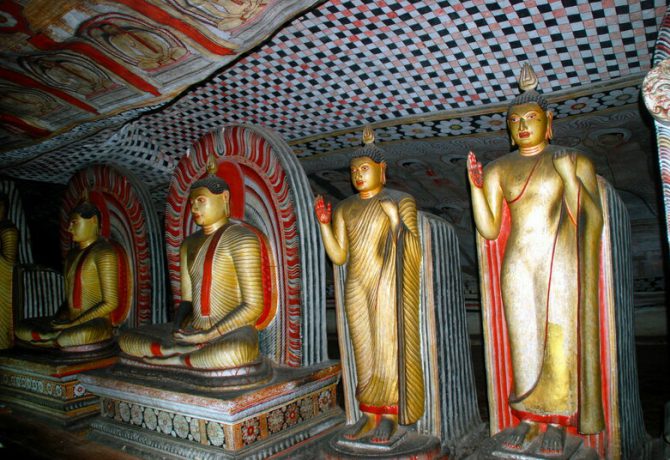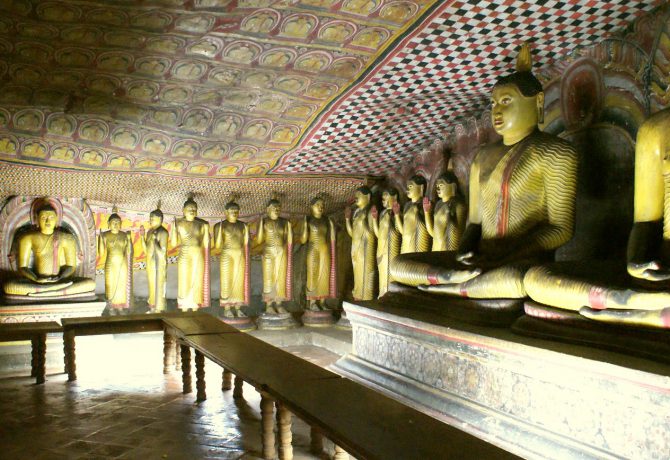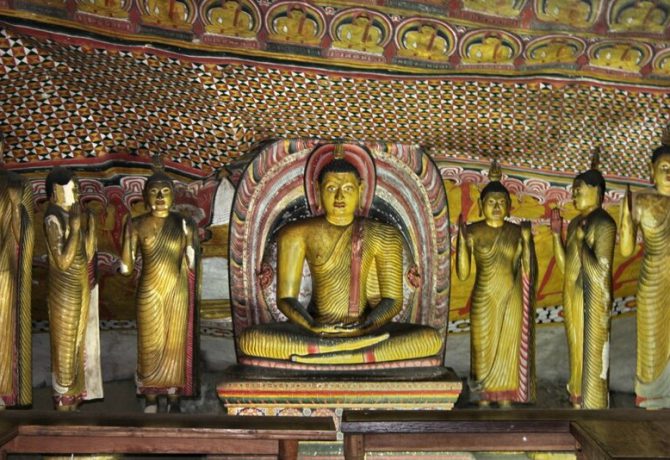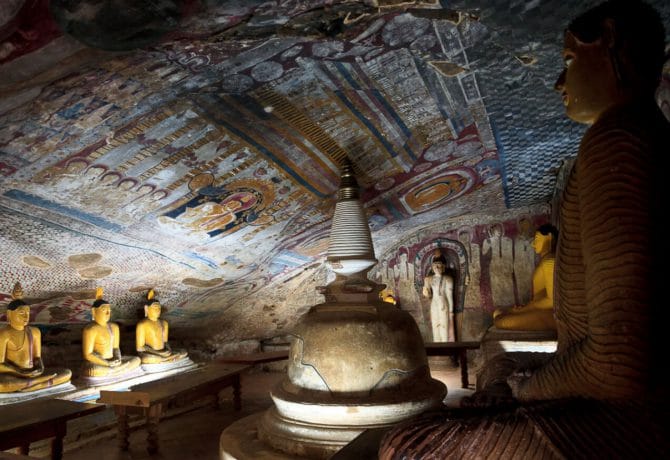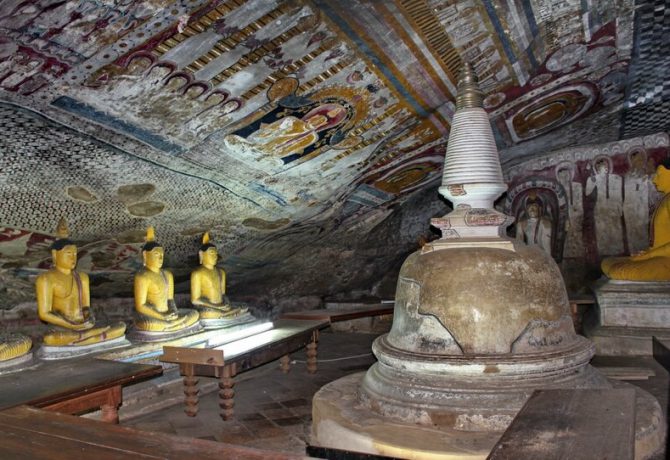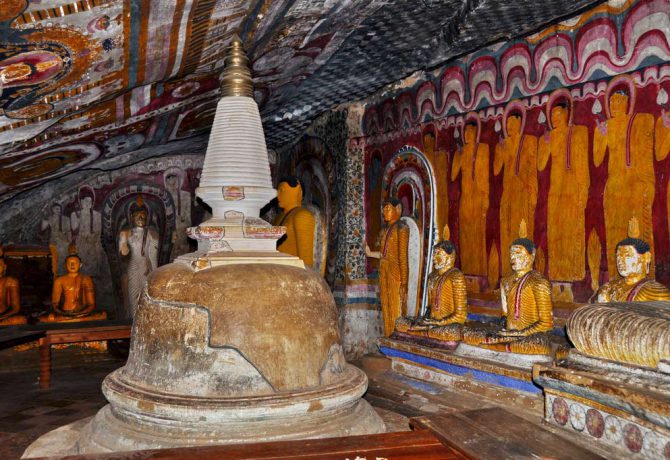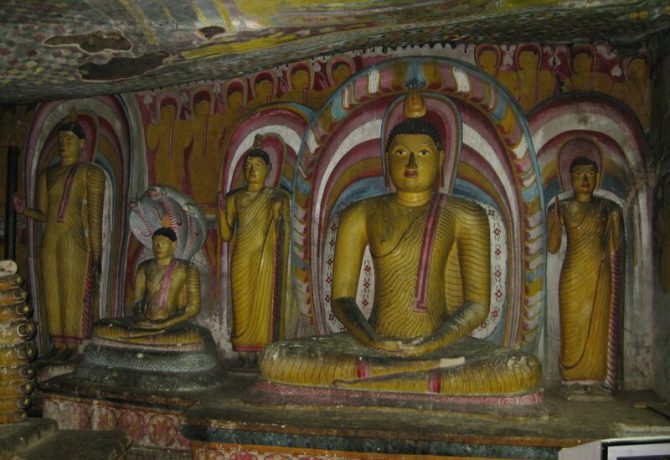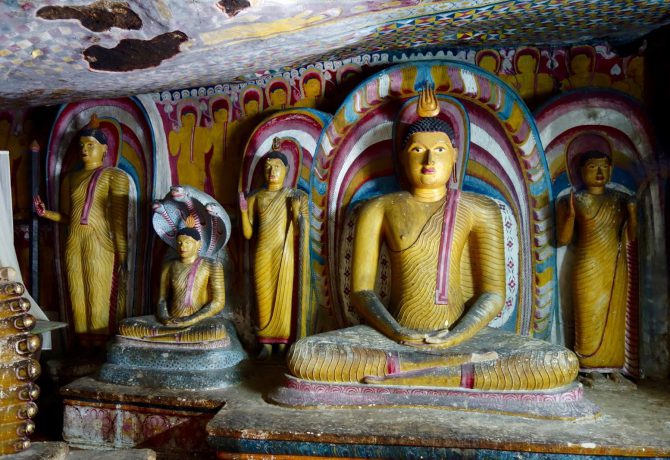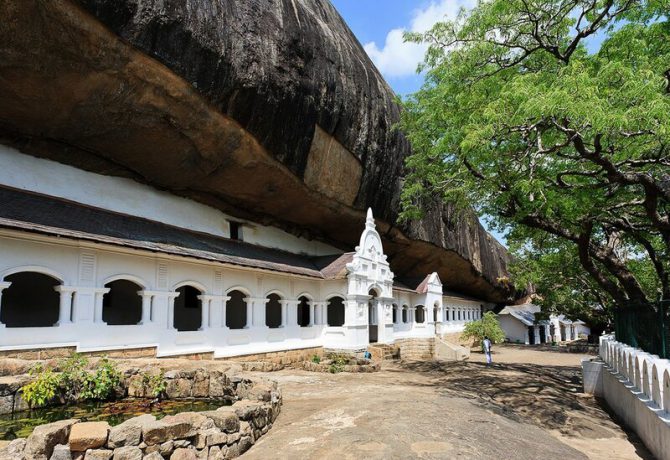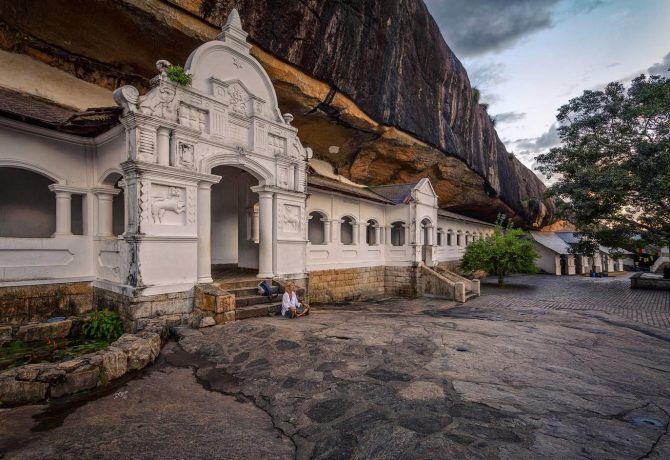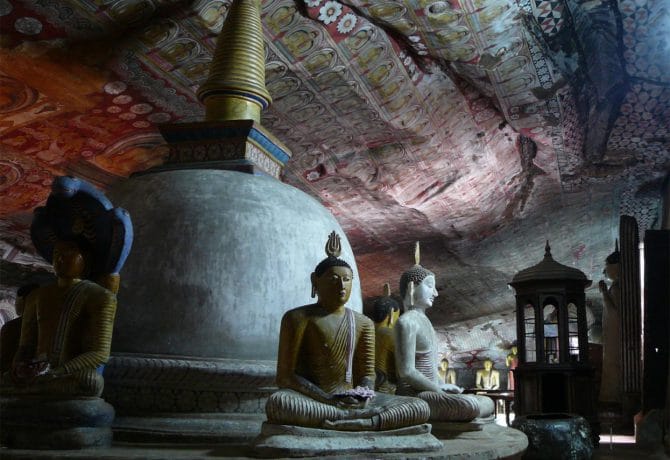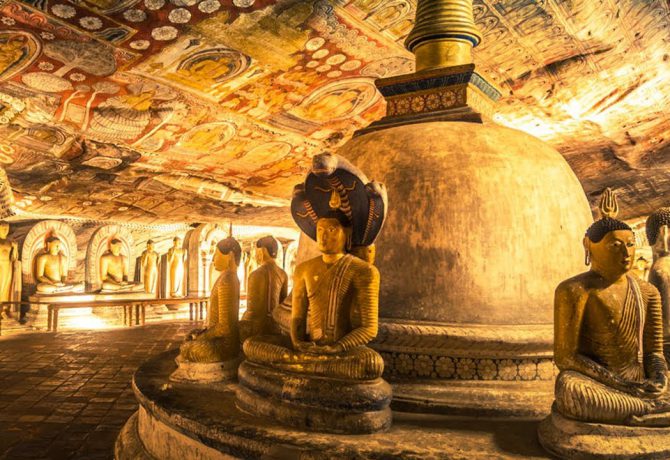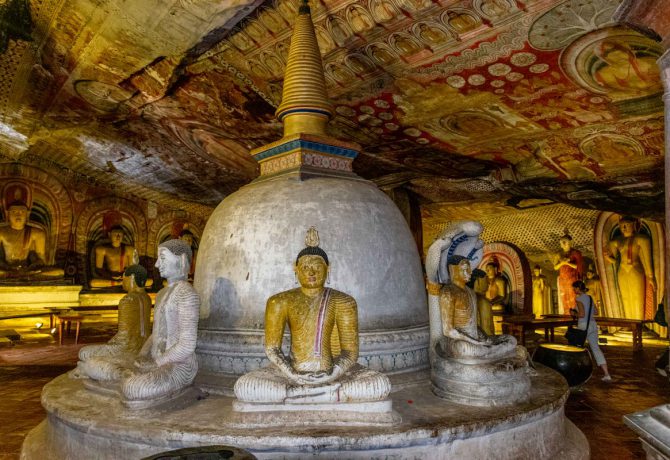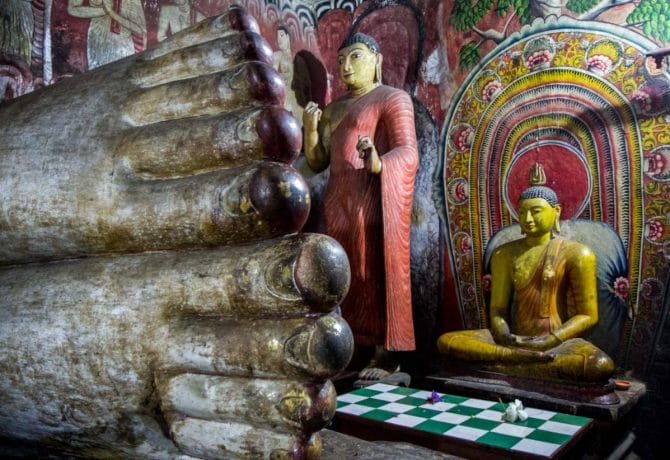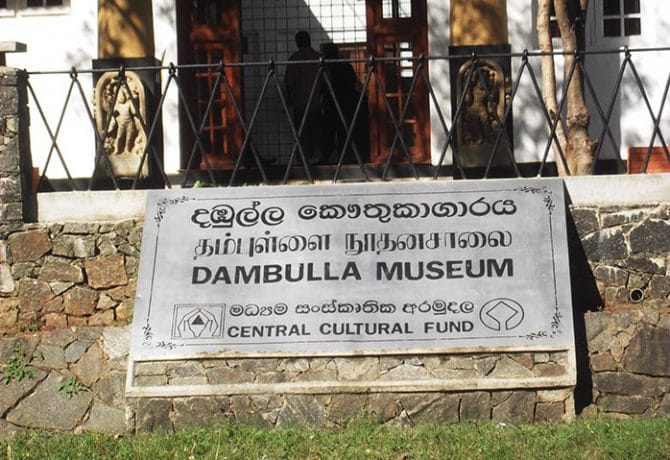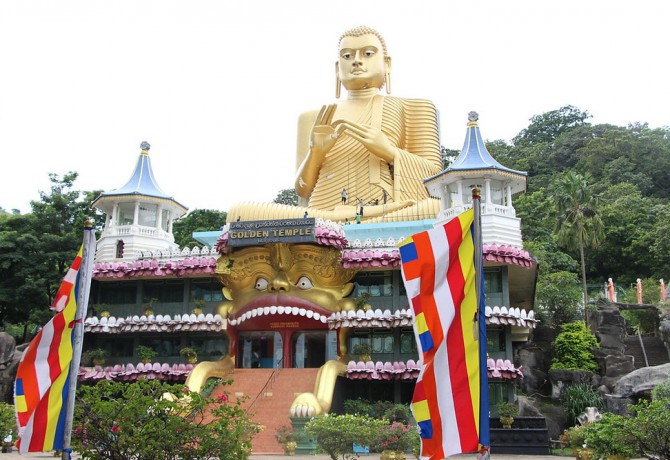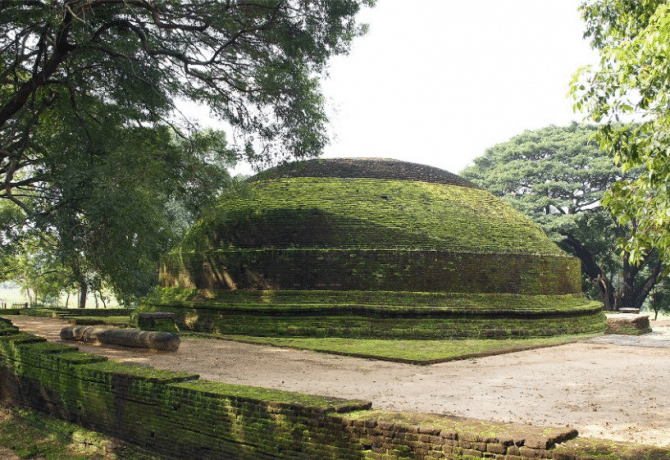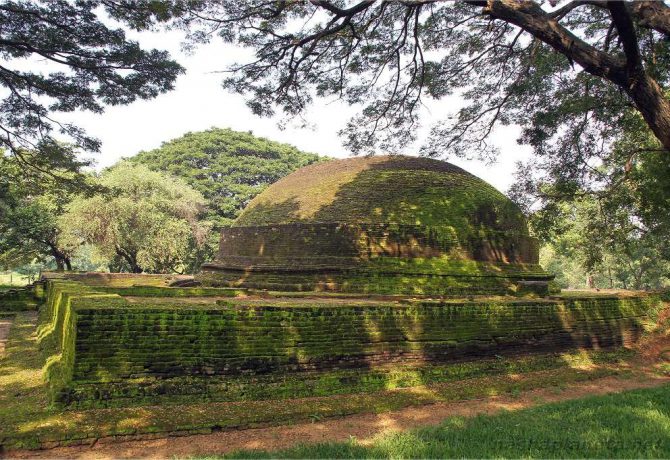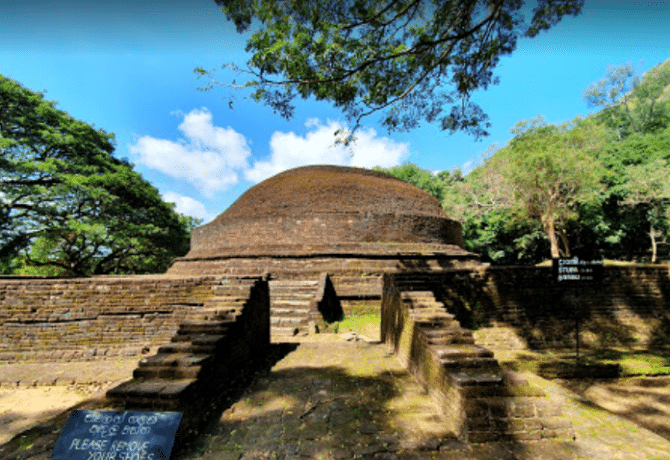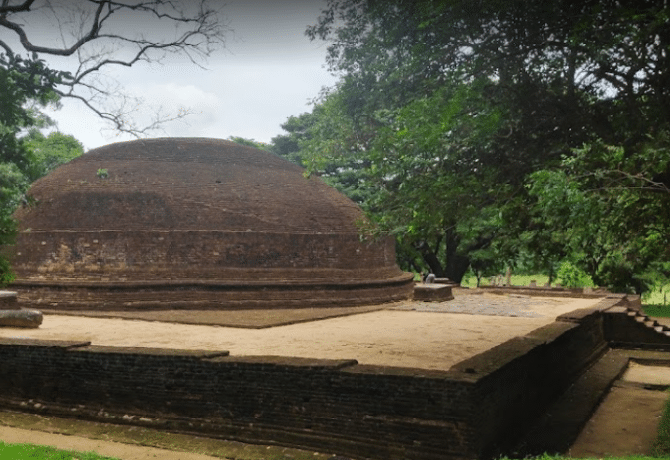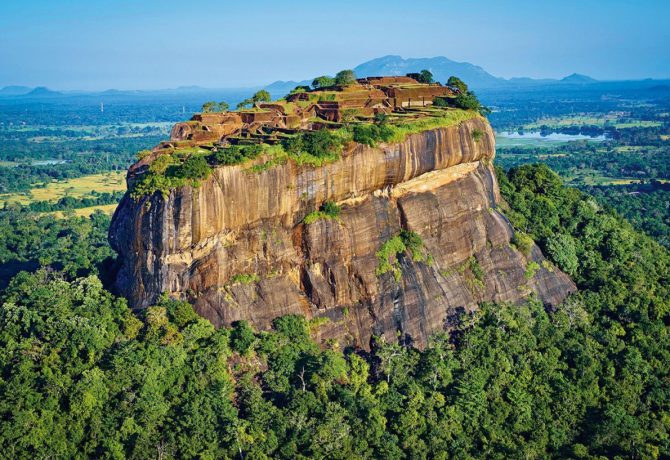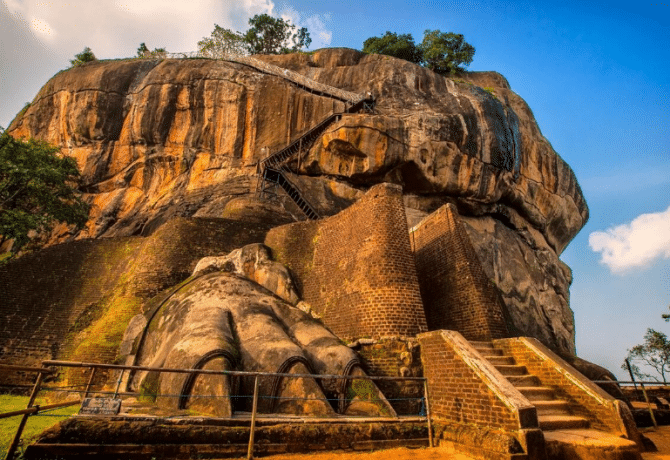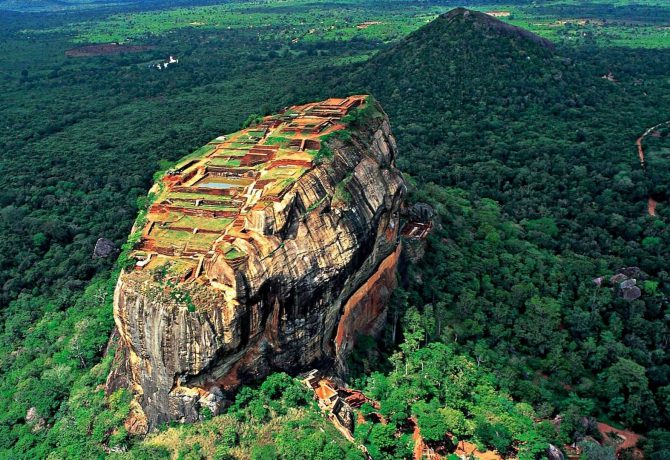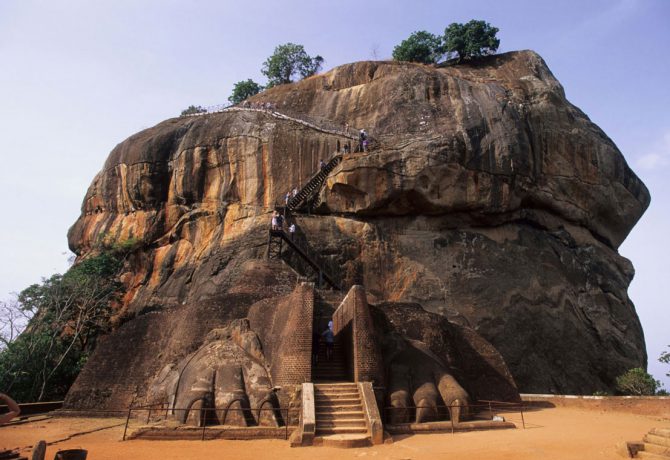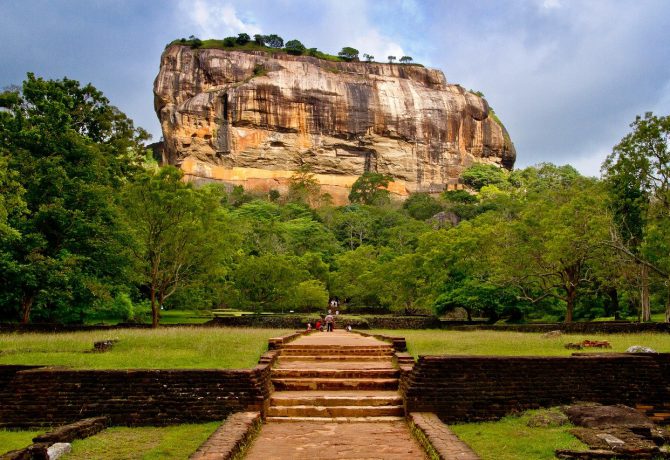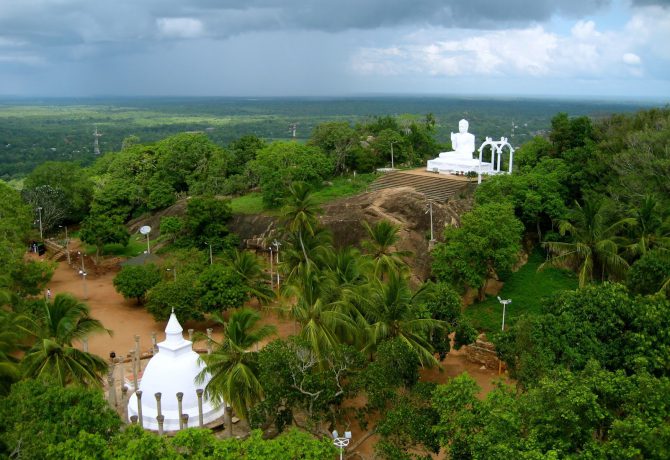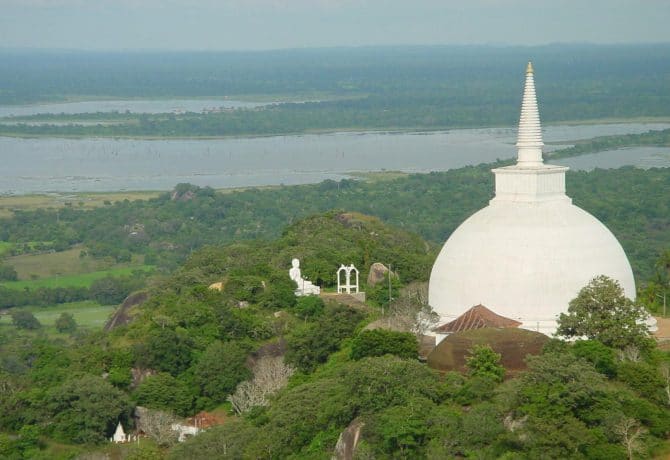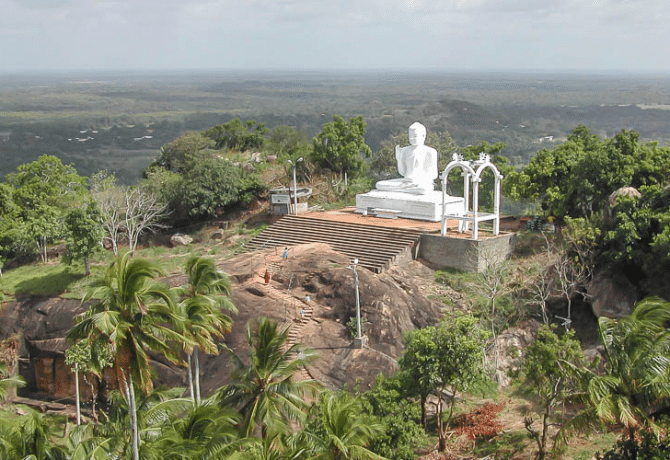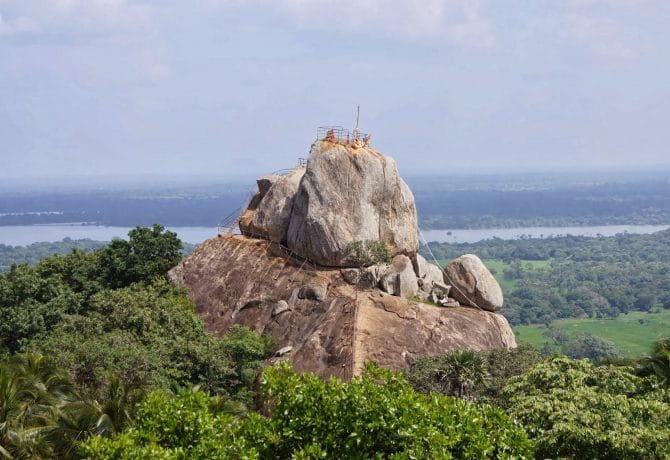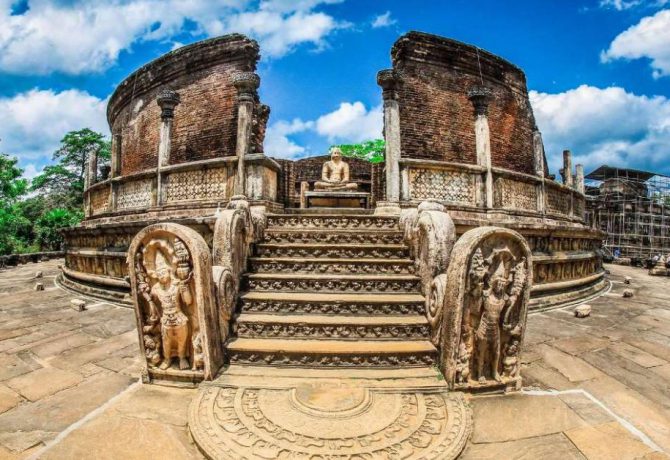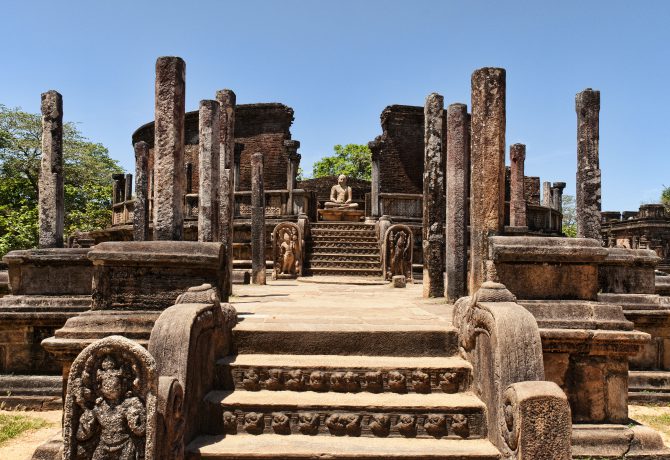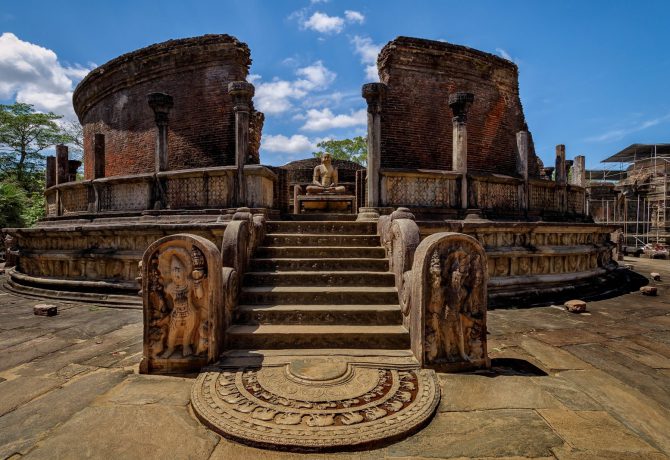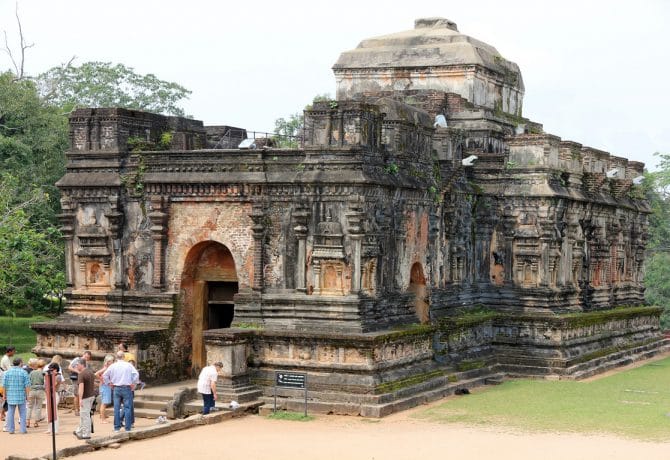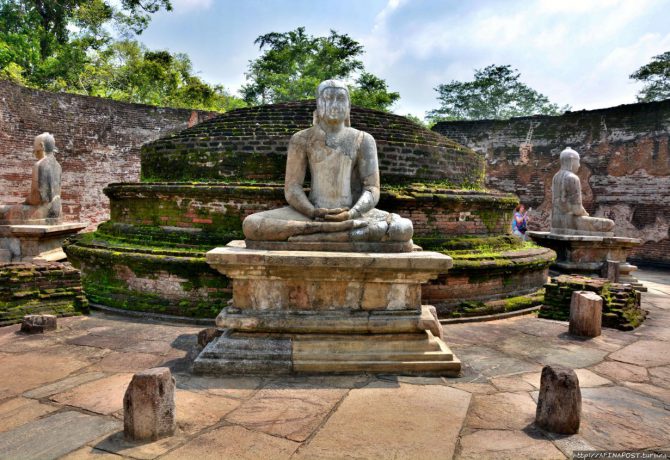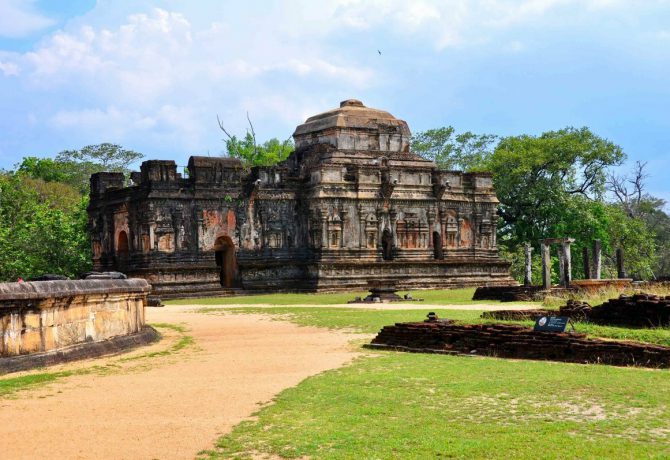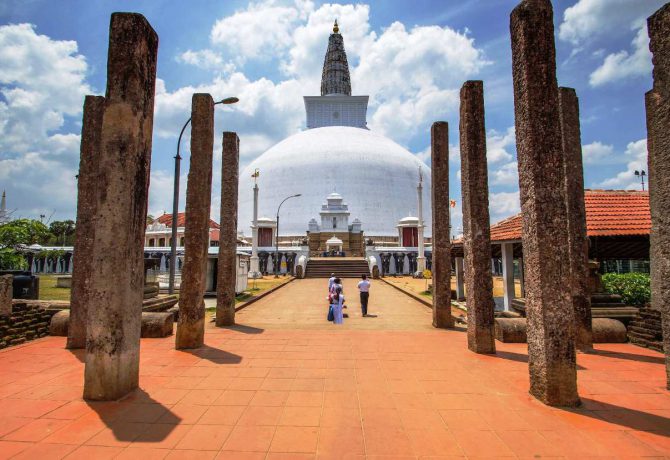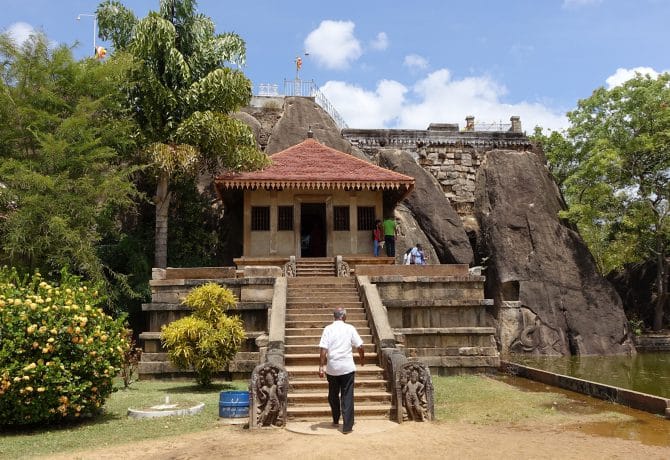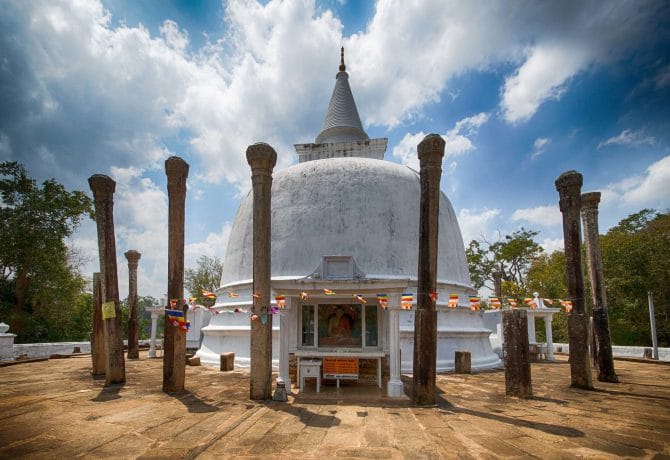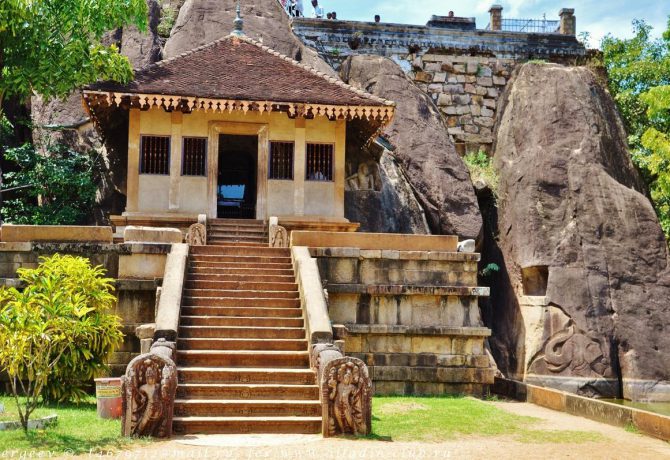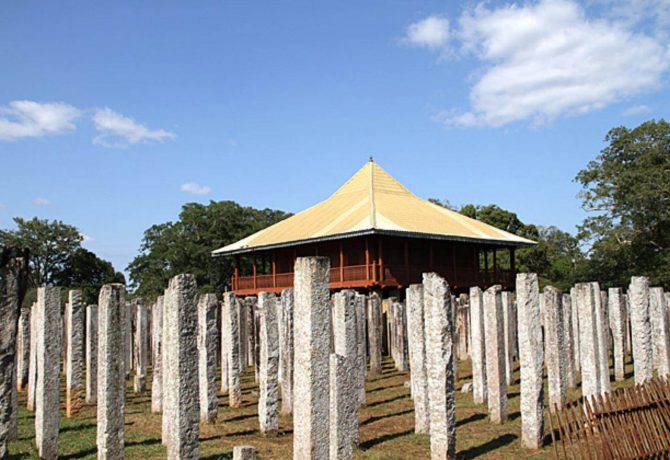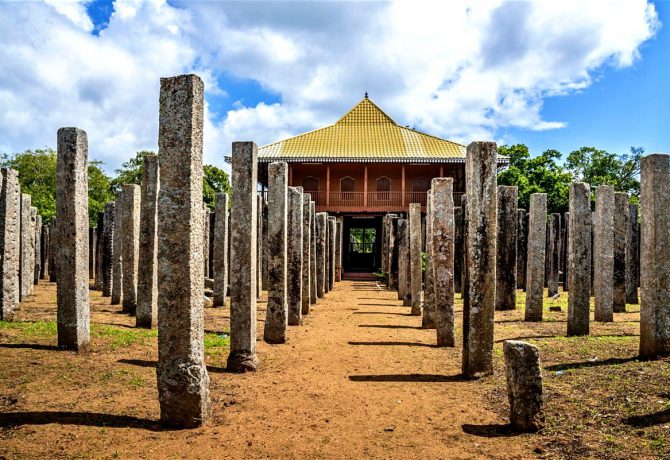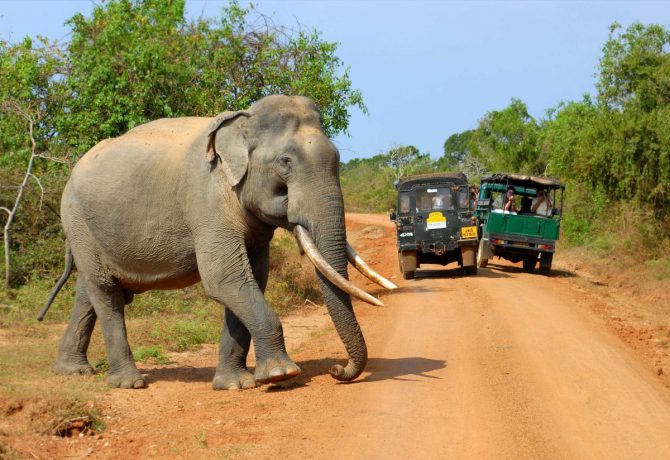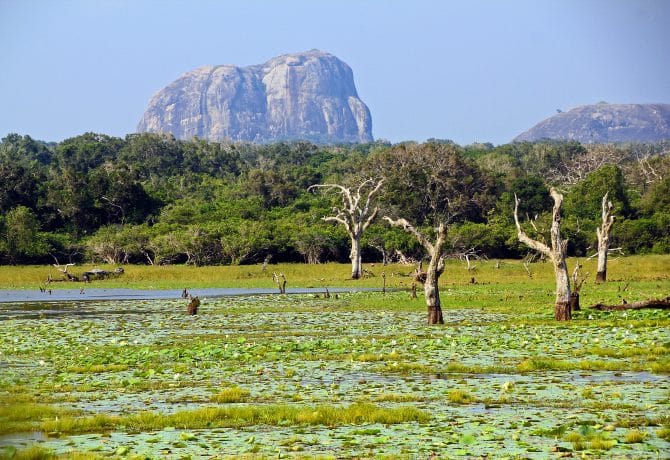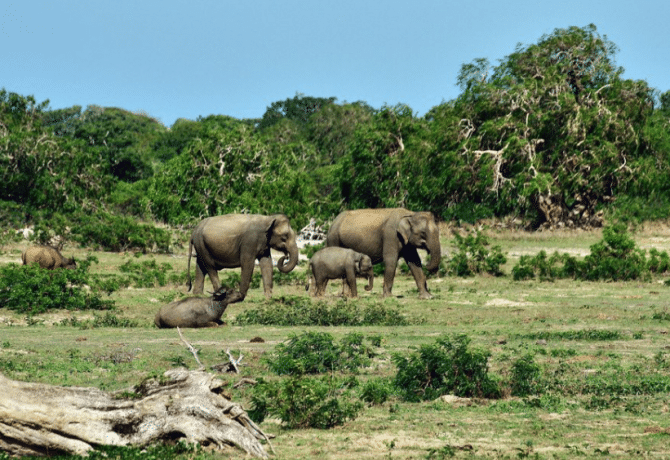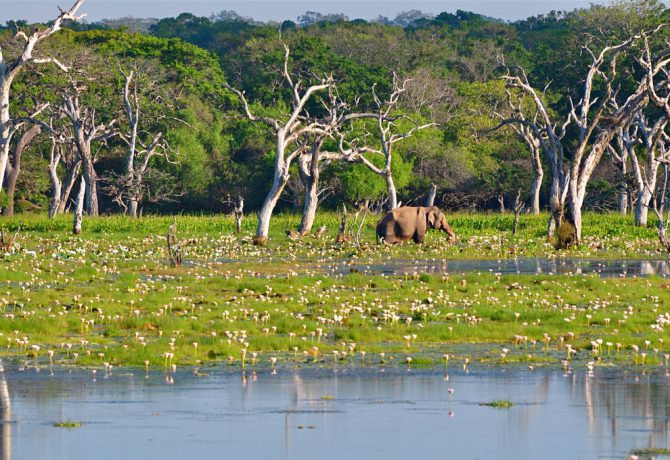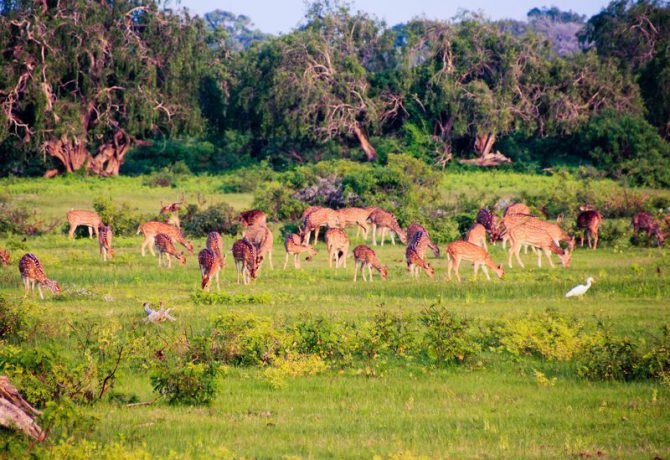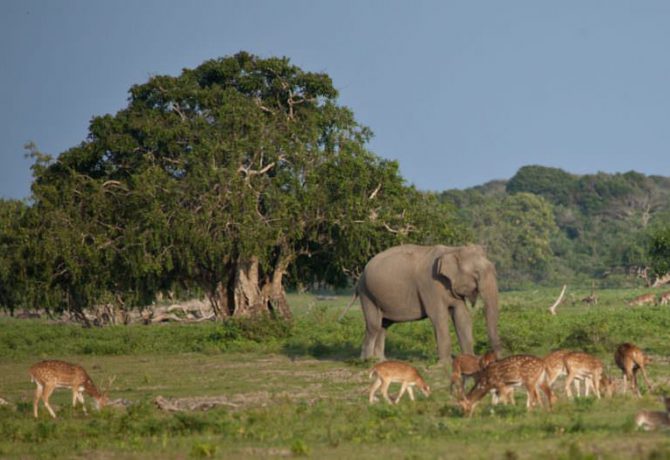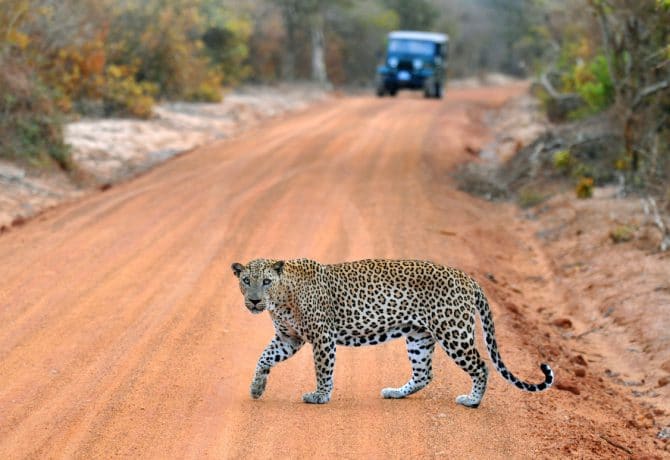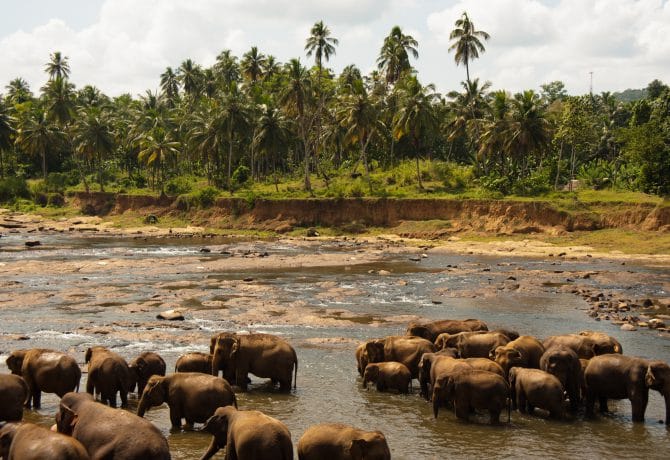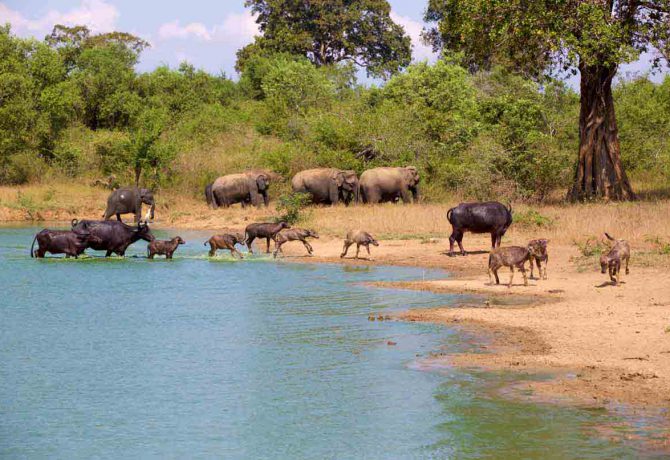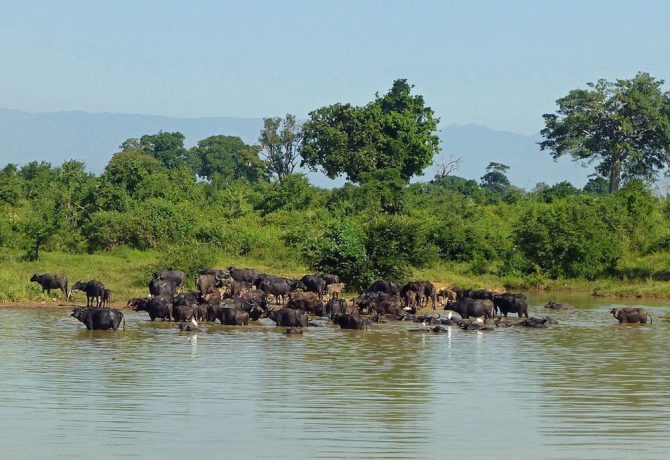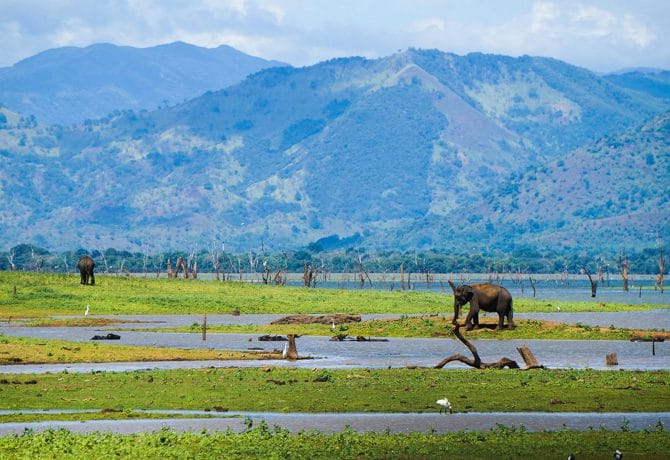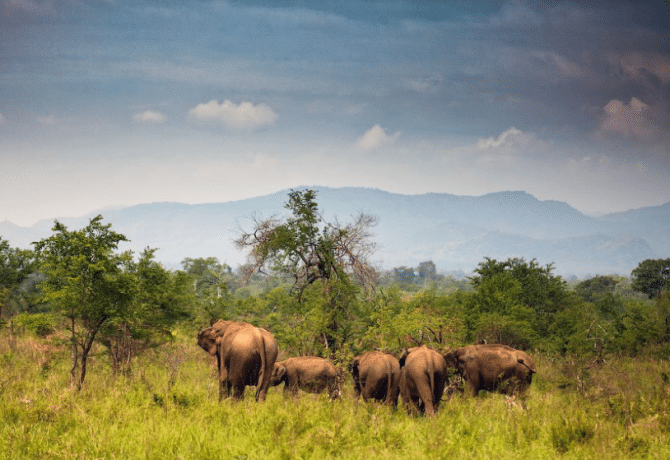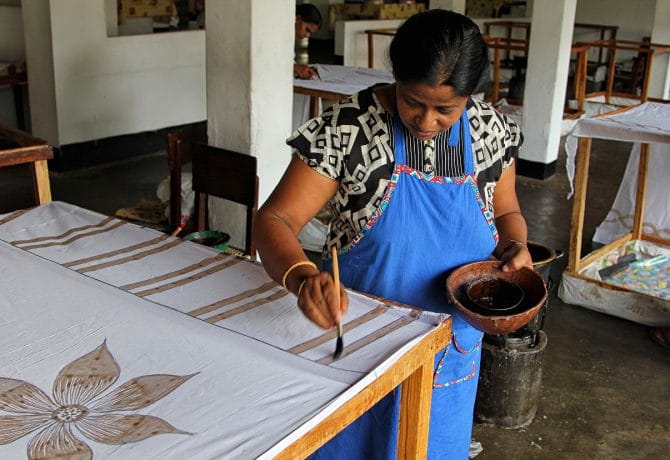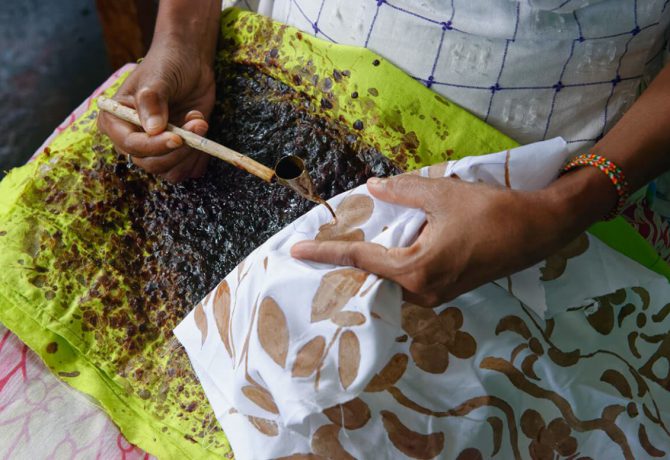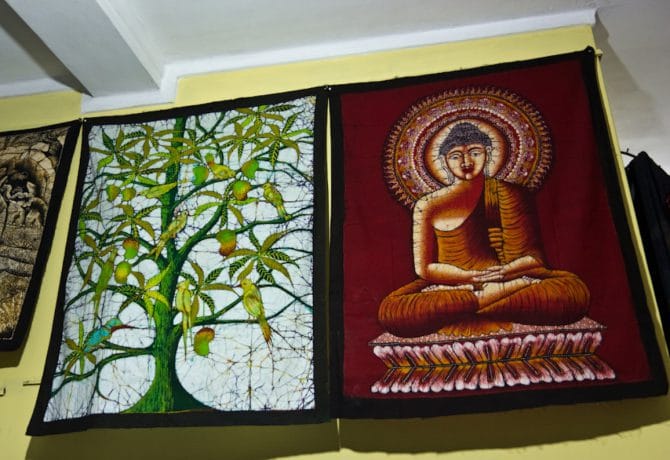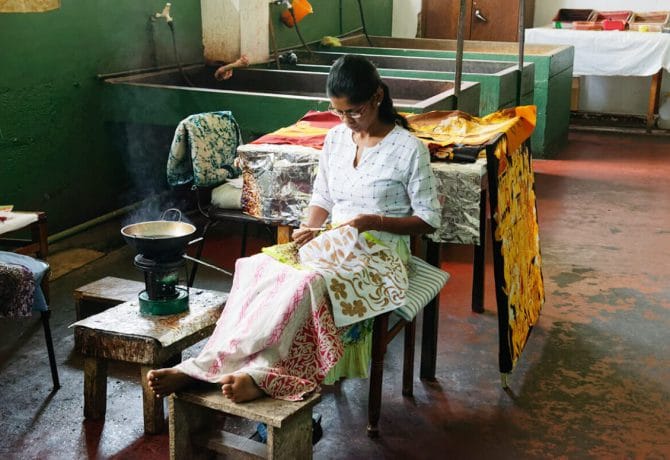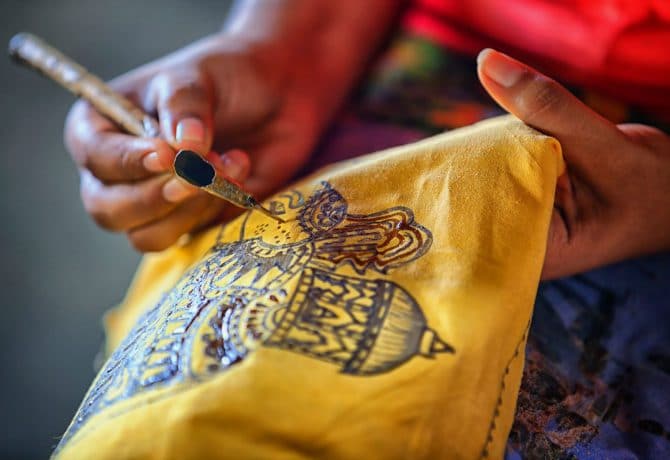The city of Dambulla is located in the center of Sri Lanka, which made it a major shopping center, but still much more important for tourists is its resort and historical orientation. Visitors to Sri Lanka associate Dambulla as one big attraction, many places here belong to the UNESCO World Heritage List, and even in a few days they can all be viewed.
All the necessary tourist infrastructure is there, and very often Dambulla serves as an intermediate point for further travel in Sri Lanka, especially to Sigiriya. The uniqueness of Dambulla in the harmonious combination of natural beauty and rich cultural heritage. Life here flows quietly and unhurriedly, and only tourists accelerate it.
When it is better to go to Dambulla for perfect weather, the question is important: almost the whole year it is hot here, the water temperature in the ocean is very pleasant, and fresh fruits are in the range. Be that as it may, there are some features of the climate that you need to remember: from April to June it is very hot and humid, and from August to March, on the contrary, it is dry, and this time belongs to the high season.
There are not many attractions in Dambulla, but their value is not in doubt. Let’s talk about the most beautiful and significant of them.
- 1 Dambulla Cave Temple
- 2 Cave of the Divine King or Maiden Raja Viharaya
- 3 Cave of the Great Kings or Maharaja Viharaya
- 4 Great New Monastery or Maha Alut Vihara
- 5 Pacchima Viharaya and Divana Alut Viharaya
- 6 Golden Temple of Dambulla
- 7 Dambullah Museum
- 8 Somawathi Stupa
- 9 Mount Sigiriya
- 10 Mihintale
- 11 Polonnaruwa
- 12 Palaces of Anuradhapura
- 13 Yala Park
- 14 Udawalawe National Park
- 15 Batik factory in Matala
- 16 Attractions Dambulla on map
Dambulla Cave Temple
The cave temple at Dambulla – one of the oldest in this region, appeared in the II century BC, a complex of 5 different caves. All of them are carved into a high rock – a very high point of the city. At the foot of the mountain stands a huge Buddha, and the stairs to the top resemble waves.
Sri Lanka is a tropical, ever-blooming country, and the area in front of the cave temple is also decorated with flowers.
Historically, the cave temple at Dambulla became a gift from King Valagambah to the local Order of Buddhist monks during the terrible time of occupation (89-103 BC).
Part of the wall above the entrance to the caves keeps the inscriptions of the Brahmins about this event.
Throughout the cave temple is the largest collection of Buddha statues, some dating back more than 2,000 years. According to the idea of the ancient builders, all 5 caves were combined into a picturesque gallery, which was restored in the 12th and 18th centuries.
You can climb the caves to the left of the Buddha statue, and the path will not seem difficult, the steps are gentle. On the way there are monkeys and peacefully walking dogs.
The entrance to the caves looks like a well-preserved gate, and according to local rules, you should undress at this point of travel. A magnificent view of the cave temple opens already behind the gate.
As we have already noted, there are only five caves, and the interior decoration of the first is the simplest, but at the same time very beautiful. Throughout the route, tourists meet numerous buddha statues, unique paintings of walls and ceilings.
Upon leaving the last cave, guests are offered another attraction of Sri Lanka, namely the striking beauty of the view of the mountains and the sunset above them.
Cave of the Divine King or Maiden Raja Viharaya
It belongs to the complex of the Cave Temple in Dambulla, which is located on a mountain 350 m high.
This is the first cave at the beginning of the tourist historical route, in short it can be called the “Divine King”. Translated from Sinhala, the part of the name translates as “grotto”, and above the entrance there are Brahmi inscriptions about the history of the creation of the monastery. The record is very ancient, made in the I century BC.
The “highlight” of the first hall is the stone figure of the Buddha 14 m high. During the long time of her stay in the cave, the restoration of the statue took place several times, and the “modern” paint was applied in the 20th century.
At the feet of the Buddha sits Ananda – his favorite pupil, and in the headboard you can see Vishnu. According to legend, he created caves by divine forces.
In this first cave, the most ancient frescoes in the complex open to the eye of tourists
Cave of the Great Kings or Maharaja Viharaya
The name of the second cave of the rock temple in Dambulla consists of three Sinhala words, so it is quite difficult for foreign guests to remember the local names. The second temple surprises with its size and a huge number of statues carved from monolithic rock, stucco and wood. There are about 60 of them: sitting, standing and lying Buddha, 4 gods Saman, Natha, Upulvan and Maitreya.
A powerful wooden statue is dedicated to King Wattagamini Abhaya, and the other to King Nissankamalla, and apparently that’s why the cave was named after these great people.
The first, according to legend, founded the temple in the I century BC, and the second decorated 50 statues with gold, but already in the 12th century.
From the crevice in the ceiling with frescoes fall drops of water (it comes from an artificial reservoir on the rock), and they are considered healing. For this reason, they are collected in a special vessel, and the locals believe that even during a terrible drought, this source will not dry up and will cure any diseases. Monks confidently say that water flows from the bottom up, contrary to all the laws of attraction.
The cave inside is covered with beautiful paintings, and all of them are applied along the curves of the rock. This is a kind of chronicle of the country, a story about the history of Buddhism in Sri Lanka. In the center of the hall there is a statue of the reclining Buddha, made in the 19th century.
Great New Monastery or Maha Alut Vihara
The third cave in the unique rock complex of Dambulla, not as ancient as the previous 2, but not inferior to them in beauty. It was built in the 18th century at the behest of King Kirti Sri Rajasinghe. He was the last ruler of the Kandy dynasty and an enlightened Buddhist. The statue of the king is presented in the cave.
The bright colors of the frescoes on the walls and ceiling of the cave amaze the visitor no less than the ancient images, and give a sea of impressions. In this cave, guests are greeted by more than 50 buddha figures the height of a man and about 1,000 images of him in frescoes. In the central part of the ceiling, the god is depicted in the meditation pose in the form of a dragon.
The main color of the third cave is red, which is how it is remembered. The dim lighting and the combination of colors create a fabulous feeling that the Buddhas around are alive and watching from every point of the cave.
According to religious tradition, in front of the central buddha statue there is an altar behind small curtains, where you can put gifts (fruits or flowers) and an urn for donations.
Pacchima Viharaya and Divana Alut Viharaya
The fourth cave of the rock temple of Pachchima Viharaya is very small and ancient, it was presented to the monks by King Valagambah in the I century BC. In the center of the hall, a white stone stupa was built, and according to one of the legends, the queen’s jewels were hidden in it. If so, then the box for storing valuables turned out to be quite large. Tomb raiders believed in the legend, and therefore relatively recently the cave was plundered.
If we define all the caves by their colors, then the palette of Pachchima Viharaya is white, and because of the antiquity, the colors, of course, have very faded and faded. Numerous Buddha statues are fenced so that they are not damaged.
Devana Alut Viharaya is the last, fifth cave in the rock complex, and for many years there was a temple warehouse here. In 1915, a restoration took place, and worshippers came to these beautiful walls again, it was opened for tourists. Closer to dusk, swallows and bats flock to the cave, and the caretakers of the temple set up special repellents.
The symbol of the fifth cave is the sleeping Buddha, under his head something like a pillow-roller, so it seems from the outside. The dominant color of the cave is yellow, very joyful and sunny. It is not known in detail who and when built this cave, but most likely, it is also about 2000 years old. It houses 11 statues of Buddha and several Indian gods.
Golden Temple of Dambulla
The most famous ancient temple of Dambulla was not in vain called golden: for many centuries it has been a center of pilgrimage and is under the protection of UNESCO.
The entire rock complex occupies a huge territory of 20 hectares, includes ancient caves with unique frescoes and Buddha statues. The importance of the Golden Temple in the history and culture of Sri Lanka and South Asia cannot be overlooked.
The place is located on a mountain, at an altitude of 350 m above sea level.
The cave part was built during the reign of many kings, and cherishes its 2000-year history. That part of the complex, which is called the Golden Temple, the newest, it was completed in the 20th century., Is located at the foot of the mountain. For tourists, there is also a museum of Buddhism and a ticket office for the purchase of entrance tickets. Please note that when buying tickets to the cave complex, the museum and the Golden Temple can be visited for free. Admire the statues of the rulers of Sri Lanka and the most important gods.
Dambullah Museum
The theme of the Museum of Buddhism is firmly connected with the main religion, its development in Sri Lanka. The exhibition presents a huge number of Buddha statues, examples of ancient frescoes and cave paintings from all over Sri Lanka and unique antiquities of the Dambulla Cave Temple. In colorful paintings you can get acquainted with the history and life of the Buddha and copies of relics.
The entrance to the museum is very simple to find: it is located at the foot of the “golden” Buddha statue with a height of 30 m.
The museum is open from 07:30 to 18:00, and you can visit it free of charge when buying tickets to the Cave Temple.
Somawathi Stupa
To the west of the Temple of Dambulla, surrounded by ruins, is the most famous stupa of Somawati. It is quite difficult to determine the age of excavations around the stupa, but archaeologists are constantly excavating there.
Legend has it that in the 2nd century BC. The enlightened Arahant made a journey to the abode of the Gods, and on his return from there, he brought the most valuable relic – the Sacred Right Tooth of the Buddha. He gave the Tooth to Queen Somawachi and the prince, and they decided to provide the relics with reliable protection. The idea to build a majestic stupa in the name of the Buddha was supported in the royal family, and everyone began to look for a place for the structure. A monastic site on the Mahaweli River was chosen, and a new temple was erected quickly. Pilgrims began to gather here to venerate the Buddha, and in the jungle nearby they founded places for meditation.
Two millennia passed for the stupa not without losses, and already in our time, in 1947, it was restored, raised from the ruins. Work was halted during the 1987 civil war, and terrorists often desecrated the shrine. The Buddha did not leave the stupa without his patronage, and miracles began to occur at this place. For example, during the battles, the monks took refuge in another place, then the stupa came to guard the elephants. After the end of the Civil War, restoration work resumed, and there was no trace of the ancient stupa. Now it is covered with a new “shell”, and a precious stone flaunts on top. In sunny weather, bright rays depart from it.
Somawati Stupa is a unique and unusual place in Dambulla.
What to see in the vicinity of Dambulla
The city of Dambulla with its sights can be explored in a few days and spend time on the ocean, and then, renting a car, go on a trip around its surroundings.
Mount Sigiriya
Sigiriya is an ancient city in Ceylon and the 8th Wonder of the World, one of the most beloved tourist destinations in Sri Lanka. The eponymous Mount Sigiriya, also called the Lion, rises almost 400 m above sea level and, together with the city, is included in the UNESCO World Heritage List.
A fortress was erected on the rock many centuries ago, and archaeological excavations have confirmed that people lived in this area in the prehistoric period. For their convenience and safety, they built caves and grottoes, and such a legacy, and the rock in particular, was discovered by a British soldier in 1831.
Long studies and excavations have made it possible to learn everything that has been built over the centuries: the palace on the top, terraces, gates, walls with frescoes, lower palaces and fortress moats.
Experts agreed that Mount Sigiriya with the fortress has been perfectly preserved since the 1st millennium, and the city plan of that time is very interesting and branched. The builders of that time thought through everything and harmoniously inscribed the buildings in the natural landscape.
Mihintale
One of the most mysterious places near Dambulla, an ancient archaeological complex. According to legend, in the III century BC. here met the Indian prince Mahinda and the Sinhala king, decided that Buddhism should become the main religion of the subjects.
Mihintale is the favorite sacred place of the Sinhalese, they know and remember from legends how the Enlightened Mahinda lived. He was just and kind, teaching wisdom and tranquility even to kings. The ruler of signals even invited him to live in the city, but Mahinda refused, considering this place a temptation. The place where the king and Mahinda met and talked about Buddhism remained in the memory of the ruler, and he decided to provide Mihintala to the Indian prince to live with the monks. After a while, a monastery was built here.
This significant event occurred in 247 BC, in June, and to this day is celebrated by locals, it is a national holiday. Pilgrims climb the rock and pay homage to the relics of Mahinda.
The archaeological park itself is large, it is necessary to see the monastery, Buddha statues, dagobas, pools and caves of monks.
Polonnaruwa
An ancient city in Ceylon, built by monks in the III century, and began as the capital of Sri Lanka. Polonnaruwa was located on the shore of the reservoir, now it is Bendiveva Lake.
Today it is not a city, but the territory of an archaeological park, where the history of the country is revealed. From the shore of the lake you can not see the boundaries of the water area, and the question involuntarily arises: how in ancient times it was possible to dig a huge reservoir for water.
The lake is unique in its beauty, but no less interesting are the buildings remaining from the noisy city.
Due to the pleasant climate, Polannaruwa was the place of residence and rest of the kings, and then it became the capital.
Polonnaruwa began to actively develop and build in the 12th century: parks, tall buildings and reservoirs appeared, but all this did not exist for long.
After 100 years, the inhabitants left the city, and ruins remained on the site of the once flourishing city.
Only in the middle of the 20th century began to restore the city, to conduct excavations, and UNESCO included Polonnaruwa in its list.
Palaces of Anuradhapura
The northern part of Central Sri Lanka is known to tourists as the city of ancient monasteries – Anuradhapura. The names of 113 rulers are associated with it, and only in the 20th century all historical monuments were discovered, they were included in the UNESCO World Heritage List.
Anuradhapura is a place of Buddhist pilgrimage, a place with unique monuments, palaces and monasteries.
Ancient documents say that the city was surrounded by a powerful wall, inside there were parks and reservoirs, they were carefully cared for.
The beauty of the royal palace and monasteries is striking even now, and in ancient times there were more than 3,000 monks in the city.
Special attention should be paid to the palaces and dagobas that appeared during the reign of the new king, they tried to get ahead of their predecessor in the elegance of the structure.
The most famous palaces of Anuradhapura are:
- The Dagoba of Jetavan was taller than the pyramids in Egypt;
- The bronze palace of Lohapasada appeared in the II century BC, was built “in the image of the sky”, bronze sheets covered its roof. The building died in a fire, in its place there were about 1600 columns and a double bath.
Despite the centuries-old destruction, the palaces in this unique city are perfectly preserved.
Yala Park
A nature reserve, Yala National Park is located in the Southeast of Sri Lanka. There are several beach resorts nearby: Hambantota and Arogam Bay.
A trip to Yala Park for adults and children is a unique opportunity to touch the life of wild animals in their habitat.
For the convenience of movement around the territory, a safari on jeeps is offered, from cars it is convenient to observe elephants, crocodiles, monkeys, buffaloes and others. Bears and leopards are more likely to appear during the dry season (July and August).
What is Yala Park? These are kilometers of tropical thickets and sand dunes, absolutely wild nature. The park is so large that on one side it is washed by the Indian Ocean, and the coastal zone is very beautiful: bays, mangroves, blue skies and bright birds in the trees.
The territory of the park is about 1000 square kilometers. km, but not all is accessible to tourists (only the western part), only scientists have the right to work on the eastern part.
This is the oldest park in Sri Lanka and the most popular among tourists.
Udawalawe National Park
Udawalawe National Park is located 180 km from Colombo, it is so large that it includes two huge areas. The well-groomed natural area became a park in 1972, and even then occupied the 5th place among the national parks of Sri Lanka. Today it is no less popular than the rest, and its size is amazing: it is more than 31,000 hectares of wildlife.
The landscapes of Udawalawe are diverse: forests, meadows, pastures and unique red-brown soils, but the Uda Walawe reservoir is considered a unique attraction.
The diverse habitats and mild climate of the region allow many species of animals to live here and reproduce. Tourists during the walk can see deer, elephants, leopards, rare birds, reptiles, and often the journey through the park is made by jeeps. This type of movement has recently become the only possible in the territory of the Udawalawe Park.
The “highlight” of the safari in the park is considered to be a meeting with Sri Lankan elephants, but they are most often found at a watering hole in the early morning or late in the evening.
Batik factory in Matala
The art of drawing on batik has long been developing in many Asian countries, Indonesia, India, Egypt and China are fighting for primacy in this art form.
Historically, batik was the first to paint craftsmen from Indonesia, and the Dutch brought it to Europe.
You can travel a lot and compare the quality of fabric decoration, but it is difficult to find such a unique performance as in Sri Lanka.
In the age of high technology, manual labor is especially appreciated, and the most classic way of drawing with melted wax.
In Sri Lanka, the production of batik is given great attention, it is part of the national culture. Workshops work both in tourist places and in small provinces. Tiny rooms in houses where craftsmen work can hardly be called production, but the locals are proud of the old methods and family skills in this.
The production of batik does not require large financial investments, materials are bought, and the equipment is used as simple as possible. It should be recognized that this work is very painstaking: processing the fabric for smoothness and elasticity, applying wax, then sketching. The choice of colors falls on the master, but each work is unique. This craft is practiced mainly by women who are capable of long-term work with their hands.
Bright and original Sri Lanka is a heavenly place to relax and explore the secret world of Buddhism. Come to Dambulla, on the shores of the Indian Ocean!

